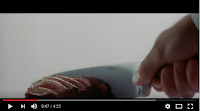Todorov's Narrative Theory:
Equilibrium:
A young girl grows up within a strict upper class family. Her father is very controlling parental figure over both her and her mother. Since she is an only child the attention is consistently on her. Therefore, the impression that she creates has to reflect well on the family, mainly her father. Moreover, she is forced into completing feminine activities such as gardening and flower arrangement. This causes her to be rather resentful of her father at a very young age.
Disruption:
The girl, Violet, hands her father some flowers that she had picked, for decoration, to put into a vase. However, she is unaware that the flowers are wolvesbane, which are extremely poisonous. She is unaware of the damage she has caused and in-affected because she is wearing gardening gloves. Her father has a heart attack shortly after. The real cause was never discovered.
Disequilibrium:
As the years pass Violet grows up to be very successful, she had almost erased her childhood from her memory, when she comes across the flower again. since it brings back such immense memories that she associates with her fathers the death, she decides to look into it, only to discover that it was in actual fact the cause of her fathers death. Since she had, had a damaging upbringing she has become very psychotic and she has took on the role of her father in terms of being controlling she has always enjoyed teasing men and being in control in any relationship she has had with them . To the point that after she has found out about this flower, she begins to use it to her advantage. She leads men on and when they get too close or clingy she'll use this flower to kill them almost as a hobby.
Attempt to repair the Disruption:
An investigator who is exploring the deaths of a numerous amount of men from the same cause starts to notice her involvement in each case but doesn't have any evidence to back up his suspicions.
New Equilibrium:
When it comes the point that she has lost control in her murders as it is only a matter of time before she is caught. She decides to take control of the only thing left, which is her life. killing herself in the same way she killed her father and all of her male victims she used to flower. This ends the narrative the same way it had begun.



